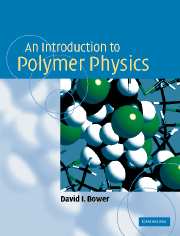Book contents
- Frontmatter
- Contents
- Preface
- Acknowledgements
- 1 Introduction
- 2 Some physical techniques for studying polymers
- 3 Molecular sizes and shapes and ordered structures
- 4 Regular chains and crystallinity
- 5 Morphology and motion
- 6 Mechanical properties I – time-independent elasticity
- 7 Mechanical properties II – linear viscoelasticity
- 8 Yield and fracture of polymers
- 9 Electrical and optical properties
- 10 Oriented polymers I – production and characterisation
- 11 Oriented polymers II – models and properties
- 12 Polymer blends, copolymers and liquid-crystal polymers
- Appendix: Cartesian tensors
- Solutions to problems
- Index
12 - Polymer blends, copolymers and liquid-crystal polymers
Published online by Cambridge University Press: 05 June 2012
- Frontmatter
- Contents
- Preface
- Acknowledgements
- 1 Introduction
- 2 Some physical techniques for studying polymers
- 3 Molecular sizes and shapes and ordered structures
- 4 Regular chains and crystallinity
- 5 Morphology and motion
- 6 Mechanical properties I – time-independent elasticity
- 7 Mechanical properties II – linear viscoelasticity
- 8 Yield and fracture of polymers
- 9 Electrical and optical properties
- 10 Oriented polymers I – production and characterisation
- 11 Oriented polymers II – models and properties
- 12 Polymer blends, copolymers and liquid-crystal polymers
- Appendix: Cartesian tensors
- Solutions to problems
- Index
Summary
Introduction
Although the properties of the polymers in the three groups considered in this chapter are in some ways very different, they share the possibility, under suitable circumstances, of self-organisation into supermolecular structures that are of different kinds from the crystallites and spherulites typical of the semicrystalline polymers discussed in the earlier chapters. These kinds of organisation give rise to properties that are of great interest both scientifically and commercially and it is the aim of this chapter to indicate some of the factors that control the various kinds of organisation and to give some indication of the wide variety of structures and properties that can be obtained.
Two or more existing polymers may be blended for various reasons. One reason is to achieve a material that has a combination of the properties of the constituents, e.g. a blend of two polymers, one of which is chemically resistant and the other tough. Another reason is to save costs by blending a high-performance polymer with a cheaper material. A very important use of blending is the combination of an elastomer with a rigid polymer in order to reduce the brittleness of the rigid polymer. It is in the latter use that the self-organising feature of some blends is seen to play a part. This feature arises when the components of the blend are incompatible, i.e. they do not mix, and they segregate into different regions within the material.
- Type
- Chapter
- Information
- An Introduction to Polymer Physics , pp. 343 - 392Publisher: Cambridge University PressPrint publication year: 2002



